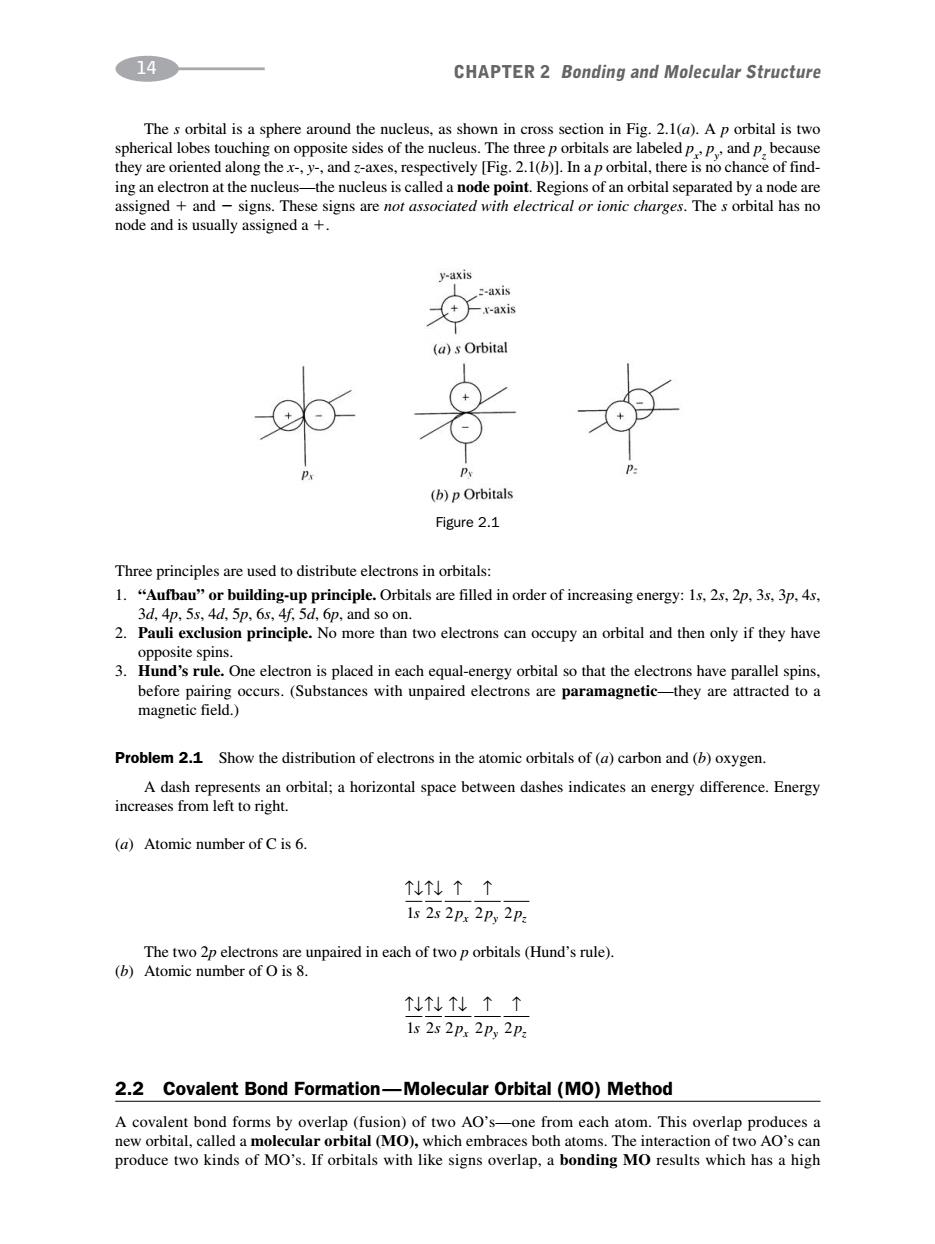正在加载图片...

14 CHAPTER 2 Bonding and Molecular Structure The s orbital is a sphere around the nucleus,as shown in cross section in Fig.2.1(a).A p orbital is two donopposite sides of the nucThe teporbitals are ab they are oriente along t ex-,y-,and respectvely a n Reg al fan or node and is usually assigned a+ y-强Xi5 (a)s Orbital c8 (b)pOrbitals Figure 2.1 Three principles are used to distribute electrons in orbitals: L这0咖f:k么3尔“ 2.Pauli excusio principle.No more than two electrons can occupy an orbital and then only if they have 3.HRa℃ One elec olaced in each orbital so that the electrons ha etic-they are attracted to a magnetic field.) Problem 2.1 Show the distribution of electrons in the atomic orbitals of ()carbon and(b)oxygen. a dash re (a)Atomic number of Cis 6. 个!个个 1s 2s 2Px 2p,2P: The two 2p electrons are unpaired in each of two p orbitals(Hund's rule). (b)Atomic number ofis8. L↑个 1s 2s 2px 2p 2pa 2.2 Covalent Bond Formation-Molecular Orbital(MO)Method A covalent bond forms by overlap(fusion)of two AO's-one from each atom.This overlap produces a The s orbital is a sphere around the nucleus, as shown in cross section in Fig. 2.1(a). A p orbital is two spherical lobes touching on opposite sides of the nucleus. The three p orbitals are labeled px , py , and pz because they are oriented along the x-, y-, and z-axes, respectively [Fig. 2.1(b)]. In a p orbital, there is no chance of finding an electron at the nucleus—the nucleus is called a node point. Regions of an orbital separated by a node are assigned and signs. These signs are not associated with electrical or ionic charges. The s orbital has no node and is usually assigned a . 14 CHAPTER 2 Bonding and Molecular Structure ↑↓↑↓ ↑ ↑ 122 2 2 ssp p p xyz ↑↓↑↓ ↑↓ ↑ ↑ 122 2 2 ssp p p xyz Figure 2.1 Three principles are used to distribute electrons in orbitals: 1. “Aufbau” or building-up principle. Orbitals are filled in order of increasing energy: 1s, 2s, 2p, 3s, 3p, 4s, 3d, 4p, 5s, 4d, 5p, 6s, 4f, 5d, 6p, and so on. 2. Pauli exclusion principle. No more than two electrons can occupy an orbital and then only if they have opposite spins. 3. Hund’s rule. One electron is placed in each equal-energy orbital so that the electrons have parallel spins, before pairing occurs. (Substances with unpaired electrons are paramagnetic—they are attracted to a magnetic field.) Problem 2.1 Show the distribution of electrons in the atomic orbitals of (a) carbon and (b) oxygen. A dash represents an orbital; a horizontal space between dashes indicates an energy difference. Energy increases from left to right. (a) Atomic number of C is 6. The two 2p electrons are unpaired in each of two p orbitals (Hund’s rule). (b) Atomic number of O is 8. 2.2 Covalent Bond Formation—Molecular Orbital (MO) Method A covalent bond forms by overlap (fusion) of two AO’s—one from each atom. This overlap produces a new orbital, called a molecular orbital (MO), which embraces both atoms. The interaction of two AO’s can produce two kinds of MO’s. If orbitals with like signs overlap, a bonding MO results which has a high �